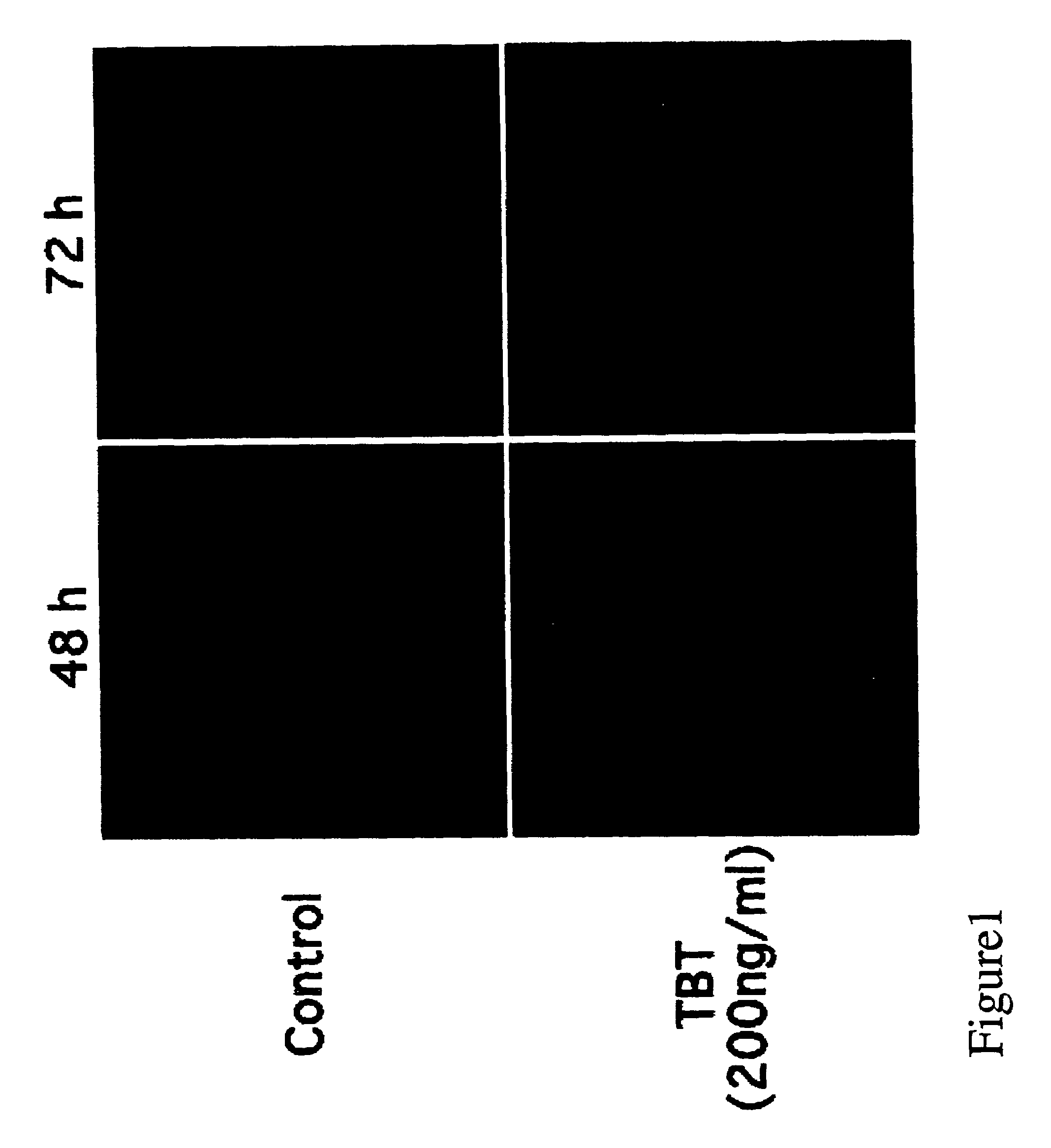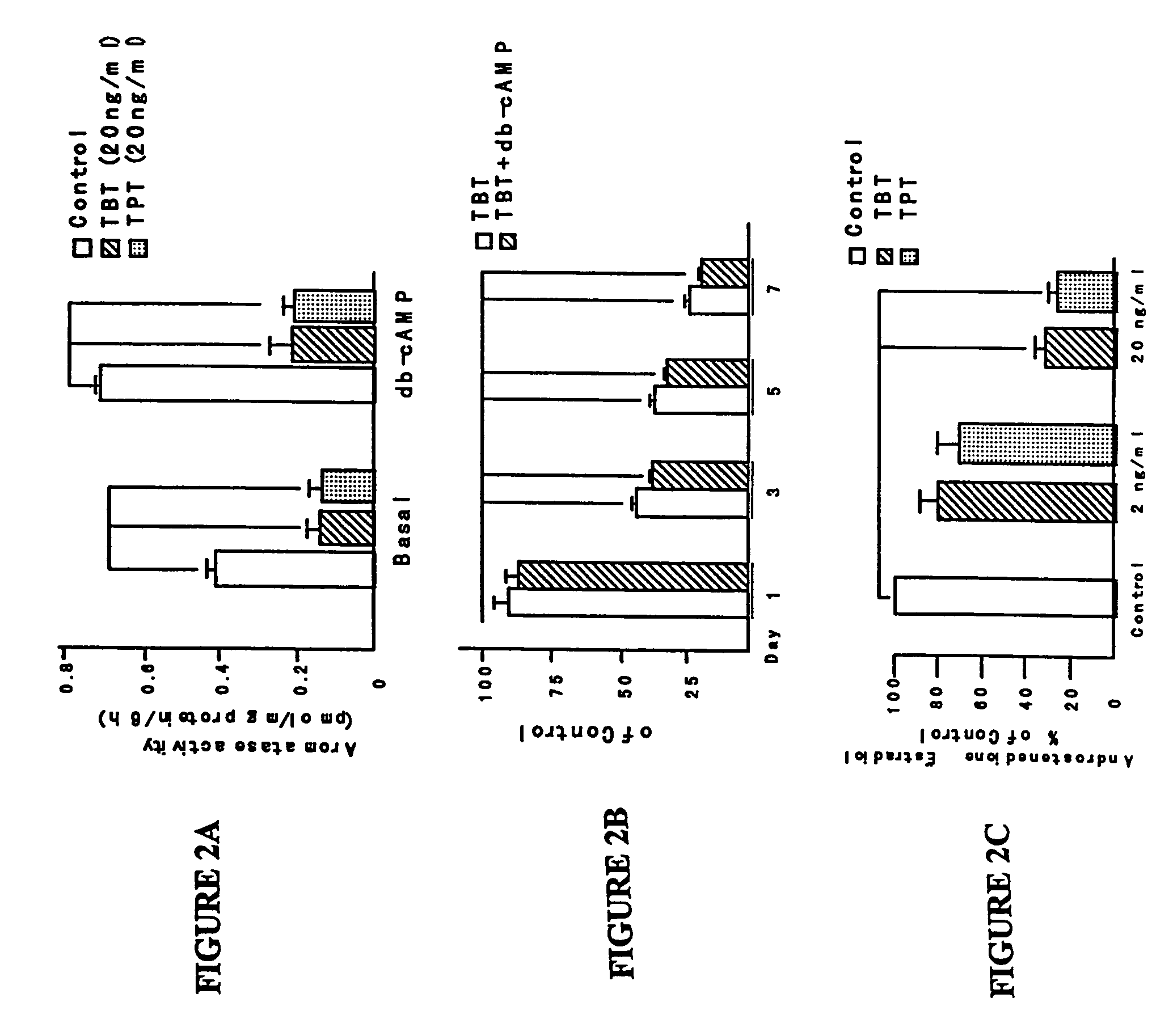Method for identifying endocrine disruptors and kit for carrying out the same
a technology of endocrine disruptors and kits, which is applied in the field of identifying endocrine disruptors using cell lines having aromatase, can solve the problems of contaminating the marine and freshwater environment with tbt, tbt has been shown to be highly toxic to a number of aquatic animals, and the biochemical mechanism of this phenomenon remains obscur
- Summary
- Abstract
- Description
- Claims
- Application Information
AI Technical Summary
Problems solved by technology
Method used
Image
Examples
example 1
Isolation of KGN Cell Line
[0039]A 63-yr-old woman with a tumor in her pelvic space was admitted to the gynecology division of Kyushu-Rosai Hospital in April 1984. After a series of clinical and laboratory examinations, a diagnosis of ovarian cancer stage III was made, and a surgical operation (total abdominal hysterectomy, bilateral salpingo-oophorectomy, and omentectomy) was performed in May 1984. The histopathological diagnosis indicated granulosa cell carcinoma. In December 1993, the tumor recurred in the pelvic region. A portion of the granulosa tumor tissue obtained at the time of reoperation in January 1994 was used as the source of the cell culture.
[0040]A specimen of enucleated granulosa tumor tissue was finely minced and dispersed into cells by treatment with 0.25% (w / v) collagenase at 37° C. for 1 h. Thereafter, the cells were cultured for several passages in a 1:1 mixture of DMEM and Ham's F-12 medium supplemented with 10% (v / v) FCS (Sera Laboratory Ltd., Sussex, UK), 100...
example 2
The Effects of TBT and TPT on KGN Cell Growth
[0048]The KGN cells possess properties similar to those of normal granulosa cells, including the expression of functional FSH receptor and a relatively high aromatase activity, as well as 17β-hydroxysteroid dehydrogenase (17β-HSD) activity. The KGN cell line can thus, produce estrogens, such as estrone (E1) and estradiol (E2), in the presence of exogenous substrate, 4-androstene-3,17-dione.
[0049]Since TBT and TPT are well-known to be toxic to several cells or to cause apoptosis (Stridh et al, Toxicol. Appl. Pharmacol., 156:141–146 (1999)), the effect of TBT and TPT on growth of KGN cells was evaluated. TBT and TPT were obtained from the Sigma Chemical Co. (St. Louis, Mo.). Further, both compounds were dissolved in ethanol, and the final concentration of ethanol in the cell growth medium was 0.1% (w / v).
[0050]More specifically, the cells were plated onto a 24-well plate at 1×104 cells / well in DMEM / F-12 supplemented with 10% (v / v) FCS. The c...
example 3
The Effects of TBT and TPT on Aromatase Activity
[0054]To evaluate the effect of TBT and TPT on aromatase activity in KGN cells, the cells were incubated with 20 ng / ml TBT or TPT for 72 h in the presence or absence of 10−4 M db-cAMP, and then aromatase activity was assessed by a [3H]H2O release assay. db-cAMP was purchased from the Sigma Chemical Co. (St. Louis, Mo.).
[0055]More specifically, aromatase activity was determined by measuring [3H] H2O release upon conversion of [1β-3H]androstenedione (A) to estrone (E1), as described by Mu et al, Biochem. Biophys. Res. Commun., 271(3):710–713 (2000). [1β-3H]androstenedione was purchased from Amersham Pharmacia Biotech (Boston, Mass.).
[0056]Initially, the cells were cultured in DMEM / F-12 with 5.0% (v / v) DCS for 48 h. After the cells were treated with either TBT or TPT as described above, [1β-3H]androstenedione was added, and the cells were further incubated for 6 h. The medium (2.0 ml) was extracted with chloroform, and was then centrifuge...
PUM
| Property | Measurement | Unit |
|---|---|---|
| concentration | aaaaa | aaaaa |
| concentrations | aaaaa | aaaaa |
| concentrations | aaaaa | aaaaa |
Abstract
Description
Claims
Application Information
 Login to View More
Login to View More - R&D
- Intellectual Property
- Life Sciences
- Materials
- Tech Scout
- Unparalleled Data Quality
- Higher Quality Content
- 60% Fewer Hallucinations
Browse by: Latest US Patents, China's latest patents, Technical Efficacy Thesaurus, Application Domain, Technology Topic, Popular Technical Reports.
© 2025 PatSnap. All rights reserved.Legal|Privacy policy|Modern Slavery Act Transparency Statement|Sitemap|About US| Contact US: help@patsnap.com



